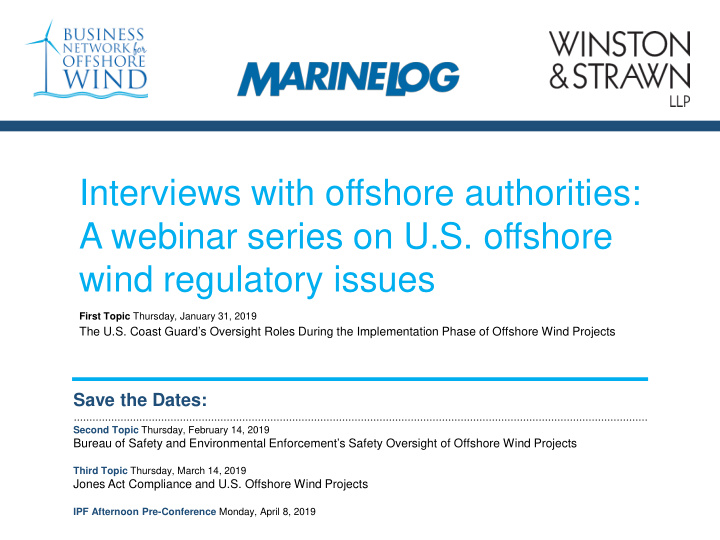



Interviews with offshore authorities: A webinar series on U.S. offshore wind regulatory issues First Topic Thursday, January 31, 2019 The U.S. Coast Guard’s Oversight Roles During the Implementation Phase of Offshore Wind Projects Save the Dates: Second Topic Thursday, February 14, 2019 Bureau of Safety and Environmental Enforcement’s Safety Oversight of Offshore Wind Projects Third Topic Thursday, March 14, 2019 Jones Act Compliance and U.S. Offshore Wind Projects IPF Afternoon Pre-Conference Monday, April 8, 2019
THE IMPLEMENTATION PHASE OF OFFSHORE WIND PROJECTS
THE U.S. COAST GUARD’S ROLE
INTRODUCTIONS Moderator: Allen Black, Partner at Winston & Strawn LLP (Washington) Edward LeBlanc, Chief of Waterways Division, Coast Guard Sector Southeastern New England Carl Moberg, Asst Chief Inspection Division, Coast Guard Sector Southeastern New England
OVERVIEW Vessel Safety & Compliance Navigational Safety Vessel Operations Maritime Security Emergency Response Marine Casualty Investigations Compliance with U.S. Laws Coordination with other agencies
VESSEL SAFETY – FOREIGN FLAG VESSELS Port State Control Regime Confirm all required int’l certificates – SOLAS Safety Construction Certificate – SOLAS Safety Equipment Certificate – Safety Management Certificate – Load Line Certificate – IOPP Certificate, IAPP Certificate
VESSEL SAFETY – FOREIGN FLAG VESSELS Vessel holds all required U.S. Certificates – U.S. Vessel General Permit NOI – U.S. Certificate of Financial Responsibiity – USCG Approved U.S. Non-Tank Vessel Response Plan
VESSEL SAFETY – FOREIGN FLAG VESSELS Vessel Examination – Compliance with certificates – Condition of vessel – Condition of vessel equipment – Crew competence – Compliance with US and international regs Pollution Prevention Safety
NTZ/ Foreign Vessel 9
NTZ/ Foreign Vessel 10
NTZ/ Foreign Vessel 11
VESSEL SAFETY – U.S. FLAG VESSELS Vessel Inspection (as applicable) “New to Zone” inspection Vessel certificates up to date Vessel condition up to standards Vessel equipment condition Crew competence Safety Management System implemented
Wind Farm Specific Vessel “SUB L/T WHY?” 13
SUB L/T OSV vs T – OSV “privileges” – Traditional crew boat & OSV ops Multi Cert vsl; Sub L (16 OSW) & sub T (48 pax) Gap analysis between T and L Damage Stability 14
NAVIGATIONAL SAFETY Review Navigation Plan – Look at support base locations, proposed waterborne logistics operations – Waterways sufficient to support proposed operations? – Bridge & Channel clearances? – Impact & Interface with other marine activities? Ensure the safety of navigation for other vessels during construction
Fueling/Loading/Logistics 16
VESSEL OPERATIONS Vessels safe for operating environment? Safety of proposed vessel operations? – Operating Weather Parameters – Vessel Operations Plans – Tower Installation – Cable-laying – Worker transfers
VESSEL OPERATIONS Support and Safety Plan – Support Vessel Operations – Evacuation Plans – Crew Support Plans
MARITIME SECURITY The Coast Guard has jurisdiction to oversee and promote maritime security for facilities and vessels within U.S. waters Offshore Wind Farm is “not currently” considered to be a “facility” But, the CG will work with the offshore wind contractor to support the security of the project and supporting vessels
EMERGENCY RESPONSE Emergency Notification and Communications Rescue and Assistance Resource Coordination Emergency Planning – Personnel Retrieval – Salvage planning
ACCIDENT INVESTIGATIONS Responsibility to investigate marine casualties Coordination with other agencies, other flag states
COMPLIANCE WITH U.S. LAWS Enforce compliance with U.S. laws – Pollution, Criminal, Customs Shared responsibilities with regard to personnel safety – BSEE / BOEM – OSHA – Local U.S. State – Flag State
COORDINATION WITH OTHER AGENCIES BOEM BSEE CBP INS States OSHA NTSB
WORKING WITH THE COAST GUARD Recognize common goals – Safety – Facilitate operations – Respect all stakeholders Early introductions -- meetings Understanding of CG organization Open communications Respect the decision process
COAST GUARD ORGANIZATION Areas Districts Sectors – Sector Commander – Captain of the Port / OCMI – Waterways – Prevention – Investigations – Response
COMMUNICATIONS Primary Point of Contact Keep persons in the loop Emails Phone calls Meetings Full disclosure – Misleading is a crime! – AND it’s never helpful
DECISION PROCESS Follow the Chain of Command May be delegations of authority Must follow statutes, regulations unless authority for exemptions Must consider other offices, stakeholders Consultation and consideration takes time
KEY POINT Open Communication is the key.
QUESTIONS AND DISCUSSION
Recommend
More recommend